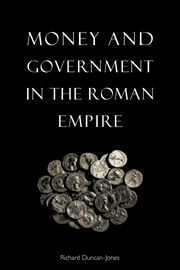6 - The implications of coin-hoards
Published online by Cambridge University Press: 08 October 2009
Summary
CHRONOLOGY
INTRODUCTION
In the last chapter, it was argued from correlations by reign with civilian handouts in Rome that most coin-hoards in this period originated from the parallel handouts to the provincial armies. If correct, that identification must mean that particular handouts generated particular groups of hoards. The first part of this chapter explores this association chronologically.
Looked at in detail, most known handouts at Rome seem to have a potential echo in the hoards found in the empire at large. But hoard-dates and the dates of handouts are often slightly out of alignment. Taken by itself, that could call the present interpretation into question. But granted the strong correlations by reign between hoards and handouts at Rome, what it suggests is that in many cases the latest coin available for handouts in the provinces may have been several years old, because of slow circulation. The amount of timelag appears to vary, thus blurring arguments from detailed chronology which could otherwise contribute to the main diagnosis. The detailed implications of that diagnosis must still be examined. But it should be understood that the associations suggested below cannot be firm identifications in the absence of more specific evidence.
Army donatives of the Principate and civilian handouts in Rome figure as joint events in the sources. Certain special occasions tended to trigger handouts. They included the accession of a new Emperor, the naming or coming of age of an heir, and the holding of a triumph.
- Type
- Chapter
- Information
- Money and Government in the Roman Empire , pp. 86 - 94Publisher: Cambridge University PressPrint publication year: 1994

